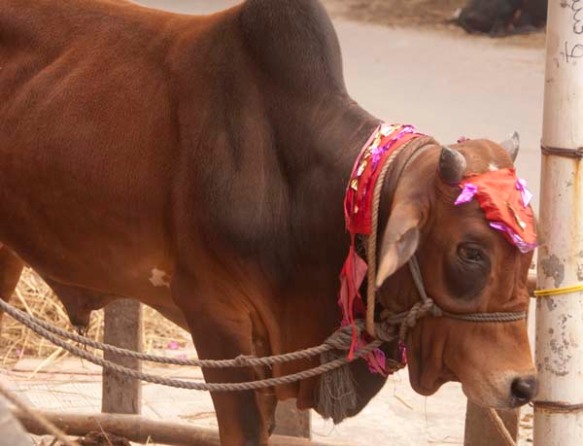“Oh! Look see how cute that goat is” said my friend as we bounced over dodgy roads in a rickshaw. Yes, the goat was unusual black with speckled ears. He and another goat were being led to their sacrificial alter.
Tonight I hear the plaintive bleating of a goat not too far away, piercing the stillness of the night. The bulls that cried out last night are quiet now. I dread tomorrow morning when much as I try to shut it out, I will hear the thump on the wooden blocks as sacrifices are made. The look of pain and anguish in the eyes of the animals on death row will haunt me for a long time.
“Sabbe sankhara dukkhati – Yada pannaya passati
Atha nibbindati dukhe – Esa maggo visuddhiya.”
“All conditioned things are painful – when with wisdom this one realizes, then is one repelled by this misery; this is the path to purity.” — The mirror of Dhamma by the venarables Narada Maha Thera and Kassapa Thera; re-edited 1975 by The venerable Kassapa Thera.
See also: Sacrificial appeasement of gods


Hope you are a vegetarian as well.
Such a beautiful photo of a very sad animal.
Hinduism and Buddhism are based on Karma. While many many individuals belonging to both faiths routinely behave in a manner where Karma is ignored, it would be useful if this instance to buy a bull or calf and gift it to a poor farmer after the festival for their livelihood. That would be good karma with immense benefit to the individual.
In the east, life and death are part of the same cycle. Just as you can have a meaningless life, you can have a meaningless death. Though my understanding of the festival is limited, I believe the meat of those animals sacrificed is distributed part to the family, part to friends and part to the poor. The sacrifice is giving up something precious (livestock) and sharing with everyone. Hopefully the animals’ deaths will have some meaning. Contrast to the modern world, where livestock and poultry are slaughtered by the millions with a large portion of it going to waste. At least, for a day, people at the festival, will have looked at the livestock they will be eating in the eye, and have some appreciation for the life that will be lost.
such a thoughtful post. so sad
Eating meat takes food from the mouths of the world’s hungry. 16 pounds of soybeans for one pound of beef, 12-14 pounds of other grains for one pound of beef. No excuses are acceptable. Fred